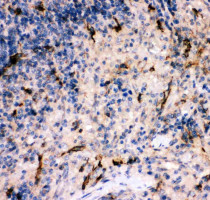ARG58310
anti-C5a / Complement C5 antibody
anti-C5a / Complement C5 antibody for IHC-Formalin-fixed paraffin-embedded sections and Rat
Overview
| Product Description | Rabbit Polyclonal antibody recognizes C5a / Complement C5 |
|---|---|
| Tested Reactivity | Rat |
| Tested Application | IHC-P |
| Host | Rabbit |
| Clonality | Polyclonal |
| Isotype | IgG |
| Target Name | C5a / Complement C5 |
| Antigen Species | Rat |
| Immunogen | Rat C5a recombinant protein (Position: D1-R77). Rat C5a shares 62% and 82% amino acid (aa) sequences identity with Human and Mouse C5a, respectively. |
| Conjugation | Un-conjugated |
| Alternate Names | ECLZB; CPAMD4; Complement C5; C5D; C5b; C5a; C3 and PZP-like alpha-2-macroglobulin domain-containing protein 4 |
Application Instructions
| Application Suggestion |
|
||||
|---|---|---|---|---|---|
| Application Note | IHC-P: Antigen Retrieval: By heat mediation. * The dilutions indicate recommended starting dilutions and the optimal dilutions or concentrations should be determined by the scientist. |
Properties
| Form | Liquid |
|---|---|
| Purification | Affinity purification with immunogen. |
| Buffer | 0.9% NaCl, 0.2% Na2HPO4, 0.05% Sodium azide and 5% BSA. |
| Preservative | 0.05% Sodium azide |
| Stabilizer | 5% BSA |
| Concentration | 0.5 mg/ml |
| Storage Instruction | For continuous use, store undiluted antibody at 2-8°C for up to a week. For long-term storage, aliquot and store at -20°C or below. Storage in frost free freezers is not recommended. Avoid repeated freeze/thaw cycles. Suggest spin the vial prior to opening. The antibody solution should be gently mixed before use. |
| Note | For laboratory research only, not for drug, diagnostic or other use. |
Bioinformation
| Gene Symbol | C5 |
|---|---|
| Gene Full Name | complement component 5 |
| Background | The protein encoded by this gene is the fifth component of complement, which plays an important role in inflammatory and cell killing processes. This protein is comprised of alpha and beta polypeptide chains that are linked by a disulfide bridge. An activation peptide, C5a, which is an anaphylatoxin that possesses potent spasmogenic and chemotactic activity, is derived from the alpha polypeptide via cleavage with a convertase. The C5b macromolecular cleavage product can form a complex with the C6 complement component, and this complex is the basis for formation of the membrane attack complex, which includes additional complement components. Mutations in this gene cause complement component 5 deficiency, a disease where patients show a propensity for severe recurrent infections. Defects in this gene have also been linked to a susceptibility to liver fibrosis and to rheumatoid arthritis. [provided by RefSeq, Jul 2008] |
| Function | Activation of C5 by a C5 convertase initiates the spontaneous assembly of the late complement components, C5-C9, into the membrane attack complex. C5b has a transient binding site for C6. The C5b-C6 complex is the foundation upon which the lytic complex is assembled. Derived from proteolytic degradation of complement C5, C5 anaphylatoxin is a mediator of local inflammatory process. Binding to the receptor C5AR1 induces a variety of responses including intracellular calcium release, contraction of smooth muscle, increased vascular permeability, and histamine release from mast cells and basophilic leukocytes. C5a is also a potent chemokine which stimulates the locomotion of polymorphonuclear leukocytes and directs their migration toward sites of inflammation. [UniProt] |
| Cellular Localization | Secreted. [UniProt] |
| Calculated MW | 188 kDa |
Images (1) Click the Picture to Zoom In






